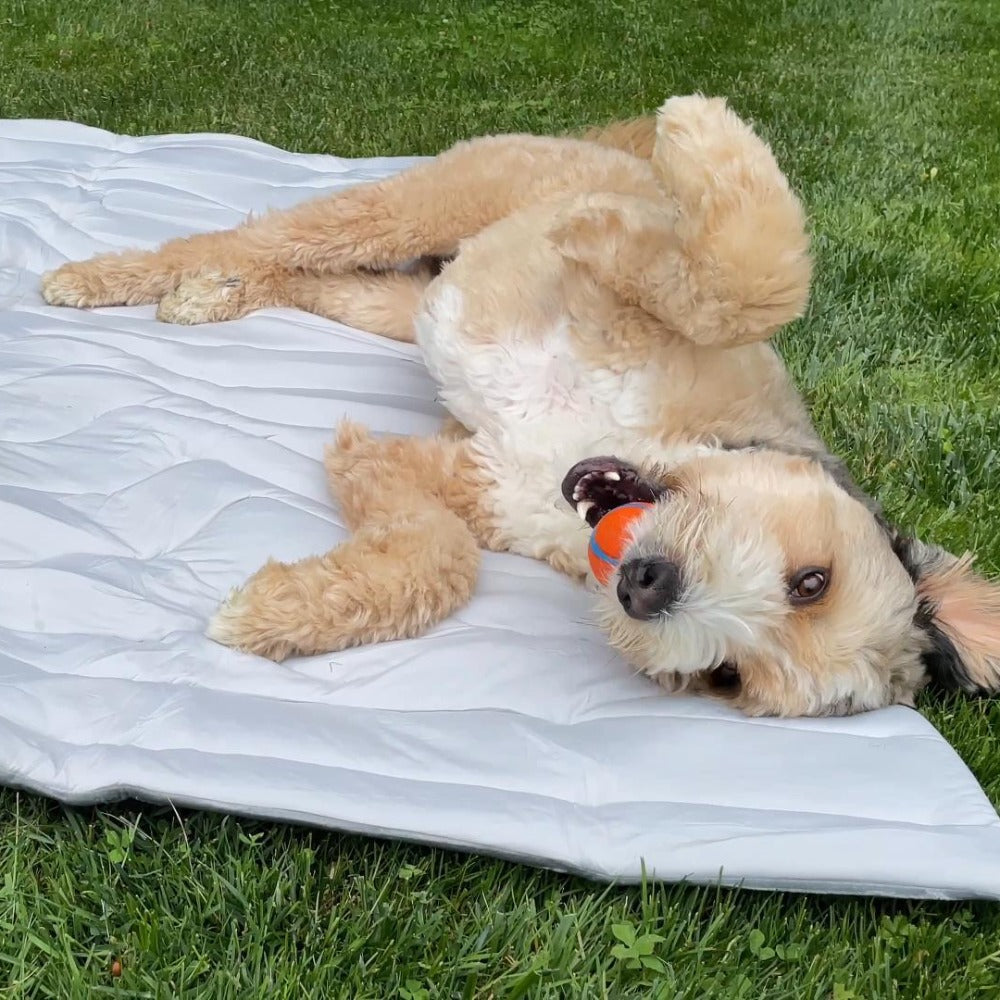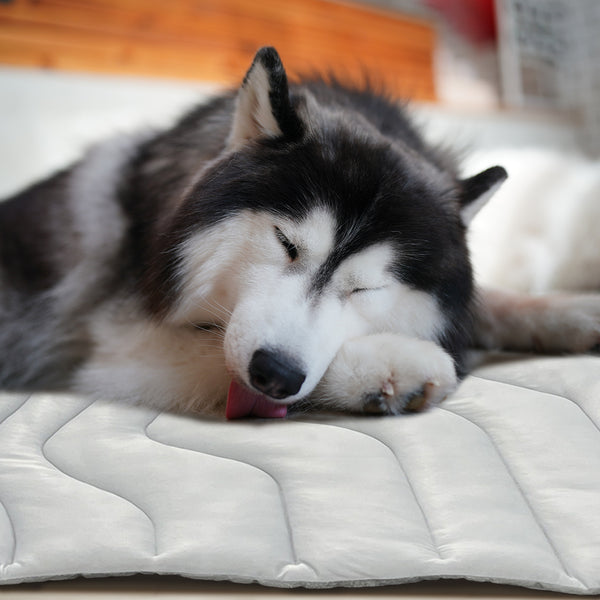Discovering that your dog is peeing in its sleep can be concerning for any pet owner. This issue affects the cleanliness of your home and raises worries about your furry friend's health.
This comprehensive guide will delve into why dogs experience this unpleasant situation and provide practical advice on managing and potentially resolving it.
Why is Your Dog Peeing in Sleep?
Urinary incontinence, the term for involuntary urine leakage, can affect dogs of any age and breed.
Various factors can contribute to your dog peeing in sleep, ranging from urinary tract infections and bladder stones to more complex conditions like spinal injuries or degenerative diseases. Understanding the underlying cause is crucial in determining the right approach to treatment.
Health Conditions Leading to Urinary Incontinence:
- Urinary Tract Infections (UTIs): It can irritate your dog's bladder, causing urgent and involuntary urination.
- Bladder Stones: These can create pressure or block the urinary tract, leading to leakage.
- Spinal Cord Diseases: Conditions like intervertebral disc disease can interfere with nerve signals to the bladder.
- Hormonal Imbalance: Especially in spayed females, reduced estrogen levels can weaken the bladder sphincter.
Diagnosing the Problem:
If your dog is peeing during sleep, visiting the vet is essential. They will likely recommend a series of tests, including urine analysis, ultrasounds, or X-rays, to determine the exact cause of incontinence. These tests help rule out infections, stones, and other potential causes.
Managing and Treating the Condition:
Treatment for a dog peeing in sleep depends on the underlying cause. Here are some common treatments:
- Medications: Drugs to strengthen the bladder sphincter or antibiotics for UTIs.
- Surgery: Needed in cases of bladder stones or significant anatomical abnormalities.
- Dietary Changes: Increasing fiber intake can help manage bladder function.
- Regular Bathroom Breaks: Increasing the frequency of bathroom breaks can help reduce the bladder's load.
Preventive Measures and Home Care:
While some causes of urinary incontinence are unavoidable, there are steps you can take to minimize the risks and manage the symptoms:
- Regular Veterinary Check-ups: Catch potential health issues before they become serious.
- Proper Hygiene: Regular cleaning to prevent infections and skin irritations.
- Comfortable Bedding: A durable, easy-to-clean pet mat can help a lot in situations where dogs may pee in their sleep. It makes cleanup easier and helps to maintain a cleaner and more comfortable sleeping environment for both pets and owners.
Long-Term Management Strategies
Behavioral Interventions:
Behavioral modifications can assist in managing urinary incontinence, especially if behavioral factors influence the incontinence.
Training your dog to empty their bladder before bedtime can help reduce accidents. Consistent schedules and frequent bathroom breaks are beneficial practices supporting bladder health.
Environmental Adjustments:
Consider the arrangement of your living space. Ensuring your dog has easy access to the outdoors or a designated bathroom spot inside can reduce the likelihood of nighttime accidents.
For older dogs or those with mobility issues, ramps or stairs to help them get outside easily can be very helpful.
Alternative Therapies
Some pet owners find success with alternative therapies alongside conventional treatments. Acupuncture, for instance, has been shown to help strengthen the urinary system in some dogs. Consult a vet specializing in holistic animal care to explore these options.
Supplements and Nutrition
Certain dietary supplements improve bladder health. Ingredients like cranberry extract and probiotics are known to support the urinary tract and may complement medical treatments.
However, always discuss supplements with your veterinarian to ensure they are safe and appropriate for your dog's health profile.
Supportive Care
Living with a dog that pees during sleep can be challenging, but several supportive measures can make daily management easier:
- Waterproof Covers and Washable Dog Beds: These products can keep your home cleaner and simplify dealing with accidents.
- Pet Diapers: Diapers can prevent urine from soiling bedding and floors, particularly for severe cases or during overnight hours.
- Skin Care: Regular cleaning of your dog’s lower abdominal area helps prevent irritation and infections caused by prolonged contact with urine.
Emotional and Social Considerations:
Maintaining a positive environment is vital, as dogs can become stressed or embarrassed by incontinence.
Show patience and compassion, offering reassurance rather than punishment when accidents occur. This can help keep your dog's spirits high and prevent behavioral issues from compounding the problem.
Veterinary Follow-ups
Ongoing veterinary care is crucial. Regular check-ups can monitor the progress of your dog's condition and adjust treatments as needed. These visits are also vital to discuss any concerns about medication side effects or changes in your dog's symptoms.
Community and Online Resources
Connecting with other pet owners facing similar challenges can provide support and practical advice. Online forums, local support groups, and social media platforms offer spaces to share experiences and tips.
Additionally, veterinary hospitals and pet health organizations provide educational resources that can offer guidance and reassurance.
Technological Advancements
In recent years, technology has begun to play a more significant role in monitoring and managing pet health conditions, including urinary incontinence.
Innovations such as smart collars monitoring a dog's vitals and activity levels can help owners and veterinarians better understand patterns contributing to nighttime incontinence. Additionally, apps that track a dog’s drinking and urination habits can be invaluable in managing their condition more proactively.
Research and Developments
Ongoing research into veterinary medicine continues to unveil new insights and treatments for conditions like urinary incontinence.
Future advancements may include more sophisticated medications with fewer side effects or gene therapy for hereditary conditions affecting bladder control.
Staying informed about the latest research can help pet owners access the most effective and innovative dog treatments.
Comprehensive Health Plans
Veterinary health plans are increasingly incorporating comprehensive approaches that consider the pet's whole health. These plans often include preventive care, which can detect signs of urinary problems before they become more severe.
Regular wellness exams and tailored health plans ensure that issues like "dog peeing in sleep" are addressed with a preventive mindset rather than merely reactive treatments.
Conclusion:
Managing a dog peeing in sleep involves a comprehensive approach that combines medical treatment, home care strategies, and emotional support.
Understanding the causes and exploring all avenues of treatment and management can significantly improve your dog's comfort and quality of life.
Remember, you're not alone in this—veterinary professionals and a community of fellow pet owners are valuable resources to help you navigate this challenging situation effectively.
With diligent care and informed choices, you can create a nurturing environment that accommodates your dog's needs and maintains a happy, loving home.



